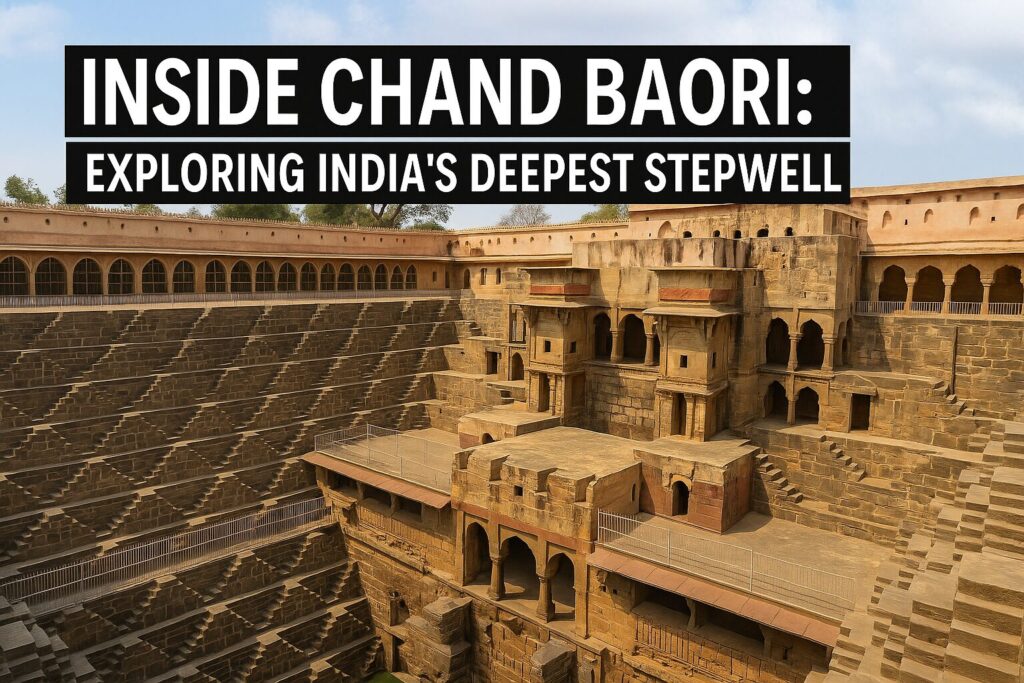Discover Chand Baori Rajasthan, India’s deepest stepwell. Explore its history, architecture, cultural significance, and travel tips for your visit.
Table of Contents
Introduction
Hidden away in the tiny village of Abhaneri lies a colossal monument that many travelers have never heard of Chand Baori Rajasthan. While Rajasthan is famed for its grand forts and opulent palaces, this ancient stepwell offers a different kind of marvel: a geometric wonder that plunges nearly 100 feet into the earth.
Imagine descending a vertiginous labyrinth of 3,500 perfectly symmetrical steps, their zigzag patterns creating optical illusions that mesmerize the eye. Chand Baori Rajasthan is not just the deepest stepwell in India it’s among the most visually stunning feats of architecture anywhere in the world.
Unlike ordinary wells, Chand Baori was built to serve both practical and cultural purposes: it stored precious water in the parched desert, provided a cool respite during scorching summers, and hosted religious ceremonies that brought the community together.
Over the centuries, it has captivated scholars, filmmakers, and curious explorers alike. Whether you’re an architecture enthusiast, a photographer in search of unique perspectives, or a history lover tracing the story of India’s ingenuity, Chand Baori stands as a testament to what human hands can achieve when necessity meets imagination.
What Is Chand Baori? A Stepwell Unlike Any Other
At first glance, Chand Baori Rajasthan resembles a vast inverted pyramid carved directly into the earth. But it’s much more than a well it is a baori, a uniquely Indian innovation designed to harvest and preserve water in regions plagued by chronic drought.
Stepwells (or baoris) are architectural structures that combine utility with artistry. Unlike ordinary wells, stepwells feature descending terraces lined with steps that allow people to reach the water table regardless of seasonal fluctuations.
Chand Baori is the most dramatic example of this form. Here’s what makes it extraordinary:
- Scale: The stepwell descends 13 stories (approximately 30 meters/100 feet) underground, making it India’s deepest and among the largest in the world.
- Complex Geometry: The 3,500 steps are arranged in a hypnotic crisscross that looks almost computer-generated in its precision.
- Cooling Effect: Even on the hottest summer days, the air at the bottom remains 5-6°C cooler than the desert above a welcome natural air conditioner.
- Dual Function: Besides providing water, Chand Baori served as a gathering place for rituals and social interactions, integrating spiritual life with survival.
No other stepwell matches this combination of scale, symmetry, and cultural importance. For centuries, Chand Baori Rajasthan has stood as a triumph of engineering that turned an inhospitable landscape into a livable environment.
The Location: Where Exactly Is Chand Baori in Rajasthan?
Chand Baori Rajasthan sits quietly in the sleepy village of Abhaneri, about 95 kilometers east of Jaipur. Although overshadowed by Rajasthan’s famous forts and palaces, this village holds one of India’s most astonishing architectural treasures.
Here’s how you can locate it precisely:
- Village: Abhaneri (sometimes spelled Abhaneri)
- District: Dausa District, Rajasthan
- Proximity to Major Cities:
- Approximately 95 km from Jaipur (the state capital)
- About 200 km from Agra, home of the Taj Mahal
- Around 240 km from Delhi, India’s national capital
To reach Chand Baori from Jaipur, most travelers take National Highway 21, which passes through Dausa and then diverts to a country road leading straight to Abhaneri. The drive typically takes 2 to 2.5 hours, making it an ideal day-trip destination.
Noteworthy Landmark Nearby:
Right next to the stepwell is the Harshat Mata Temple, an ancient shrine dedicated to the goddess of joy and happiness. Visiting both sites together provides a window into how religion and water conservation intertwined in Rajasthan’s past.
Many visitors combine Chand Baori Rajasthan with a Golden Triangle itinerary (Delhi-Agra-Jaipur) because it lies almost midway between Jaipur and Agra. Yet despite this convenient location, it remains blissfully uncrowded, offering a rare chance to explore at your own pace.
A Glimpse into History: Who Built Chand Baori and When?
Chand Baori Rajasthan was built more than a millennium ago, long before modern engineering could calculate its geometry by computer. Historians trace its origins to the reign of King Chanda of the Nikumbha Dynasty, who commissioned its construction sometime around 800-900 CE.
The Nikumbha Rajputs ruled parts of this region when Rajasthan was a patchwork of small kingdoms. Though King Chanda is less known than the later Rajput dynasties of Mewar or Marwar, his legacy endures through this colossal stepwell that still bears his name (“Chand” in Chand Baori comes from him).
Key Historical Details:
- Era of Construction: 8th-9th century CE
- Purpose: Primarily water conservation, secondarily a community hub and a site for religious ceremonies
- Later Additions: During the 10th century, parts of the Harshat Mata Temple and decorative elements were added, blending Hindu architecture with later influences
According to architectural scholars, Chand Baori’s design evolved over generations. Each ruling dynasty contributed embellishments intricate stone carvings, pillared pavilions, and niches that once held statues of deities.
One fascinating insight: British explorers in the 19th century often wrote about Chand Baori with astonishment, unable to believe that a pre-modern society could create such geometrical precision without advanced tools.
Today, Chand Baori Rajasthan is protected by the Archaeological Survey of India, recognized not only for its age but also for its unparalleled architectural sophistication.
Why Was Chand Baori Built? Function and Cultural Significance
In Rajasthan’s arid plains, where rain is scarce and summer temperatures often exceed 45°C (113°F), the need to secure water year-round shaped both daily life and cultural identity. Chand Baori Rajasthan arose as an ingenious response to these harsh conditions.
Practical Function:
The stepwell stored rainwater and groundwater, acting as a reservoir that could sustain the community through prolonged droughts. Its depth tapped the subterranean water table, while the vast surface area captured runoff during monsoons.
- During monsoon season, rainwater flowed down the steps, filling the tank.
- In dry months, villagers walked down to access cool water.
- The well was also used for irrigation of nearby fields.
Cultural and Spiritual Role:
Chand Baori wasn’t only a utilitarian structure. It was also a place where life’s milestones unfolded.
- Religious Ceremonies: The adjacent Harshat Mata Temple meant the stepwell was a venue for rituals and festivals dedicated to the goddess of joy.
- Community Gathering: In a time before air conditioning, Chand Baori’s cool subterranean chambers became a natural refuge. People gathered here to escape the heat, exchange news, and socialize.
- Symbol of Prosperity: Owning a massive baori demonstrated a ruler’s commitment to the welfare of his subjects. It projected power and piety in equal measure.
An architectural historian once described stepwells as “India’s subterranean cathedrals” sacred, communal spaces that blurred the lines between survival and spirituality. Chand Baori Rajasthan is perhaps the most striking illustration of that ethos.
Incredible Architecture: The Design of 3,500 Steps and 13 Stories
One of the most astonishing aspects of Chand Baori Rajasthan is its hypnotic geometry. Standing at the edge, you see a canyon of perfectly aligned steps cascading down like a giant inverted pyramid a design so precise that it seems almost otherworldly.
Key Architectural Highlights:
- 3,500 Steps: The steps are arranged in a symmetrical crisscross pattern descending on three sides. This unique zigzag allows people to reach the water no matter how low the level falls.
- 13 Stories Deep: Chand Baori plunges approximately 30 meters (nearly 100 feet), making it the deepest stepwell in India.
- Three Sides of Steps: While three sides feature rows of steps, the fourth side has an elaborate pavilion with balconies, carved jharokhas (overhanging enclosed balconies), and two projecting galleries.
- Cool Microclimate: The descending design traps cool air, creating a temperature difference of 5-6°C lower than the surface above functioning as an early form of air conditioning.
- Visual Illusions: As you look down, the repetition of steps creates optical illusions. Some visitors describe feeling slightly disoriented by the “infinite” perspective.
One fascinating detail: archaeologists have noted that the slope and spacing of the steps were carefully calculated to ensure stability during seasonal flooding and drought cycles. Even after more than a thousand years, the structure has remained remarkably intact.
Notable Architectural Features:
- Ornate sculptures and niches once held idols and decorative motifs.
- A royal pavilion provided shaded platforms where dignitaries could sit.
- Stone columns support tiered verandas with intricate latticework.
Many architectural experts regard Chand Baori Rajasthan as the finest example of the baori tradition combining mathematics, aesthetics, and function in one enduring monument.
Chand Baori in Pop Culture: From Hollywood to Bollywood
Though once hidden in obscurity, Chand Baori Rajasthan has now found a surprising second life on the silver screen. Its hypnotic design and mysterious atmosphere have made it a favorite backdrop for filmmakers across the world, from Bollywood epics to Hollywood blockbusters.
Hollywood Appearances
- The Dark Knight Rises (2012):
Perhaps the most globally recognized moment for Chand Baori came when it was featured as the “prison pit” from which Bruce Wayne escapes. Though some scenes were recreated on a set, the actual footage of the deep stepwell used in the film comes from Chand Baori. The haunting imagery added a layer of metaphorical depth to Batman’s journey. - The Fall (2006):
This visually extravagant film by Tarsem Singh features scenes shot in exotic locations worldwide including Chand Baori. Its geometric grandeur fit perfectly into the film’s surreal visual storytelling.
Bollywood and Indian Cinema
While Chand Baori isn’t as frequently seen in Indian mainstream cinema, it has been featured in:
- Bhool Bhulaiyaa (2007): Some sequences use the eerie and symmetrical visuals of Chand Baori to evoke mystery and intrigue.
- Paheli (2005): The film, starring Shah Rukh Khan and Rani Mukerji, captures Rajasthan’s cultural soul, including glimpses of traditional stepwells like Chand Baori.
Music Videos and Documentaries
- The site has also appeared in music videos, fashion editorials, and National Geographic documentaries that explore ancient engineering marvels of the world.
- In recent years, travel YouTubers and architecture influencers have spotlighted Chand Baori, helping it gain viral fame on Instagram and TikTok for its “infinite staircase” illusion.
Thanks to its cinematic charm, Chand Baori Rajasthan has transcended its geographic location to become a symbol of India’s architectural genius on a global stage.
Best Time to Visit Chand Baori and What to Expect
Planning a trip to Chand Baori Rajasthan requires a bit of timing to make the most of this remarkable site. While it’s open year-round, the climate in this part of Rajasthan can be extremely hot and dry, so choosing the right season is key.
Best Time to Visit
- October to March: These months offer the most pleasant weather, with daytime temperatures ranging from 20-30°C (68-86°F). This is ideal for exploring the steps without risking heat exhaustion.
- Avoid May-June: Temperatures during peak summer can exceed 45°C (113°F), making the descent into the well quite uncomfortable despite its natural cooling effect.
- Monsoon Season (July-September): While rains are not as intense as in other parts of India, occasional showers can make the steps slippery. Still, the monsoon can add a lushness to the surroundings if you’re prepared.
What to Expect When You Arrive
- Visual Impact: The first glimpse over the edge is unforgettable. Many visitors describe feeling a sudden vertigo when confronted by the geometric drop.
- Crowds: Chand Baori remains relatively uncrowded compared to Jaipur’s forts and palaces. Expect small groups of tourists and occasional school trips.
- Photography: Early morning and late afternoon offer the best light. The play of shadows on the steps creates dramatic photos.
- Local Guides: Knowledgeable guides are usually available at the entrance, offering tours in English and Hindi. A guided tour can reveal historical details you might miss on your own.
- Amenities: Facilities are basic there is a small parking area, a few stalls selling water and snacks, and simple restrooms near the entrance.
Visitors often combine their trip to Chand Baori Rajasthan with a visit to the adjacent Harshat Mata Temple, which adds cultural depth to the experience.
Nearby Attractions You Shouldn’t Miss in Abhaneri
Though Chand Baori Rajasthan is the main draw, Abhaneri and its surroundings offer a handful of lesser-known gems that deepen your understanding of the region’s history and culture.
Here are the highlights you should consider adding to your itinerary:
1. Harshat Mata Temple
- Located just a few steps from Chand Baori, this 9th-century temple is dedicated to Harshat Mata, the goddess of joy and happiness.
- While partially ruined by centuries of invasions and time, the temple still showcases exquisite carvings of deities, dancers, and floral patterns.
- Scholars believe that the temple and stepwell were part of a single complex designed for both worship and sustenance.
2. Bhandarej Baori
- About 30 km away, in the village of Bhandarej, you’ll find another ancient stepwell. Though less elaborate than Chand Baori, it offers insights into how widespread stepwells were in this region.
3. Mehandipur Balaji Temple
- Located approximately 35 km from Abhaneri, this temple is dedicated to Lord Hanuman and attracts devotees from across India.
- Known for its unique rituals, it can be an eye-opening cultural experience if you have time to explore beyond architectural heritage.
4. Dausa City
- Dausa is the district headquarters and has a vibrant local market where you can browse traditional Rajasthani handicrafts, fabrics, and pottery.
5. Jaipur
- Since Chand Baori Rajasthan is often visited as a day trip from Jaipur, you can also plan to see Jaipur’s highlights like Amber Fort, Hawa Mahal, and City Palace before or after your visit to Abhaneri.
Insider Tip:
If you love photography, plan to spend extra time around Harshat Mata Temple. The morning light striking the temple and stepwell together creates unforgettable images that few tourists capture.
Travel Tips: Entry Fee, Timing, and Local Guides
Visiting Chand Baori Rajasthan is relatively straightforward, but a few practical details can help you make the most of your trip and avoid common pitfalls.
Here’s everything you need to know before you go:
Entry Fee and Timing
- Entry Fee:
- Indian Nationals: Free
- Foreign Nationals: Free
(Note: Occasionally, a small fee is collected for photography or videography equipment, but casual phone cameras are typically exempt.)
- Opening Hours:
- Daily from sunrise to sunset (approximately 8:00 AM to 6:00 PM)
- Open all days of the week, including public holidays
- Best Time to Visit:
- Early morning or late afternoon for cooler temperatures and better lighting
Local Guides
- Knowledgeable local guides are usually available right at the entrance.
- Rates are negotiable but typically range from ₹200-₹500, depending on the duration and language.
- A good guide will share legends, point out architectural details, and explain the cultural context making your experience far richer than wandering alone.
Facilities and Accessibility
- Restrooms: Basic but functional facilities are available near the entrance gate.
- Food and Drinks: A few small stalls sell bottled water, snacks, and tea. For a proper meal, you’ll need to stop in a nearby town or return to Jaipur.
- Parking: Ample free parking for cars and tour buses right outside the complex.
- Accessibility:
- The upper viewing platform is accessible to all.
- Descending the steps is restricted for safety reasons, so you’ll admire most of the well from above.
- If you have mobility challenges, you can still enjoy the views from the perimeter.
Pro Tip:
Bring a hat, sunscreen, and plenty of water, especially if you visit between March and June. Even though Chand Baori Rajasthan is cooler at the bottom, the area around the well can be extremely hot.
Why Chand Baori Deserves a Spot on Your Rajasthan Itinerary
Rajasthan is overflowing with wonders majestic forts, golden deserts, and vibrant bazaars but Chand Baori Rajasthan offers something utterly unique: an encounter with ancient ingenuity on a scale you won’t find anywhere else in India.
Here’s why it should be on your must-see list:
- One-of-a-Kind Architecture:
Nowhere else will you see 3,500 steps arranged in a perfect geometric labyrinth descending 13 stories into the earth. The effect is mesmerizing, both in photos and in person. - Off the Beaten Path:
While Jaipur and Agra are often overrun with tourists, Chand Baori remains blissfully serene. You’ll have time and space to appreciate its beauty without battling crowds. - A Window into India’s Water Heritage:
Stepwells like Chand Baori remind us that sustainable water management isn’t a modern concept ancient builders were solving drought challenges with brilliance centuries ago. - Cinematic Legacy:
From The Dark Knight Rises to The Fall, the stepwell has captured the imagination of global audiences. Standing at the edge, you’ll feel like you’ve stepped onto a movie set. - Easy Day Trip:
Its location just under 100 km from Jaipur makes it an accessible addition to any Golden Triangle itinerary. You can visit in a morning and be back in the city by afternoon. - Cultural Richness:
Pair your visit with the adjacent Harshat Mata Temple to experience how daily life, spirituality, and survival intertwined in medieval Rajasthan.
Whether you’re a photographer hunting for India’s hidden gems or a traveler fascinated by ancient engineering, Chand Baori Rajasthan will leave you awestruck.
Conclusion
Chand Baori Rajasthan is not just a relic of the past it’s a living testament to human creativity, resilience, and the deep relationship between culture and environment. In a region defined by extremes blistering heat, scarce water this colossal stepwell provided relief and connection for centuries.
Its hypnotic pattern of 3,500 steps is more than a visual spectacle; it’s a precise instrument that sustained life in a desert and became a gathering place where faith, community, and ingenuity converged. As modern India evolves, Chand Baori stands as a reminder that sustainable design can be both functional and profoundly beautiful.
For travelers who crave more than postcard-perfect palaces and forts, Chand Baori Rajasthan offers an experience that is immersive, uncrowded, and deeply moving. Standing at its edge, you feel the weight of a thousand years pressing gently against your imagination.
If you are planning your Rajasthan itinerary, make space for this hidden marvel. It deserves not just a quick photo stop but the time to reflect on the brilliance of those who built it and the enduring lessons it holds for us today.





